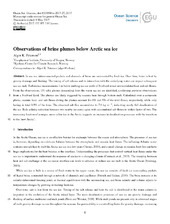Observations of brine plumes below Arctic sea ice
Journal article
Submitted version
Permanent lenke
https://hdl.handle.net/1956/16780Utgivelsesdato
2017Metadata
Vis full innførselSamlinger
- Geophysical Institute [1198]
Originalversjon
https://doi.org/10.5194/os-2017-27Sammendrag
In sea ice, interconnected pockets and channels of brine are surrounded by fresh ice. Over time, brine is lost by gravity drainage and flushing. The timing of salt release and its interaction with the underlying water can impact subsequent sea ice melt. Turbulence measurements 1 m below melting sea ice north of Svalbard reveal anti-correlated heat and salt fluxes. From the observations, 131 salty plumes descending from the warm sea ice are identified, confirming previous observations from a Svalbard fjord. The plumes are likely triggered by oceanic heat through bottom melt. Calculated over a composite plume, oceanic heat- and salt fluxes during the plumes account for 6% and 9% of the total fluxes, respectively, while only lasting in total 0.5% of the time. The observed salt flux accumulates to 7.6 kg m−2, indicating nearly full desalination of the ice. Bulk salinity reduction between two nearby ice cores agree with accumulated salt fluxes to within factor of two. The increasing fraction of younger, more saline ice in the Arctic suggests an increase in desalination processes with the transition to the ’new Arctic’.

